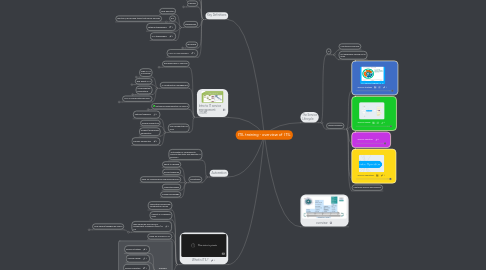
1. Key Definitions
1.1. service
1.1.1. Delivering Value
1.1.2. Facilitating Outcomes
1.1.3. "A set of specialized organizational capabilities for providing value to customers in the form of services"
1.1.4. Official definition
1.1.4.1. "A means of delivering value to Customers by facilitating outcomes customers want to achieve without the ownership of specific costs or risks. The role of the Service Provider is to manage these costs and risks appropriately, spreading them over multiple customers if possible"
1.2. customer
1.2.1. "Someone who buys goods or services. The customer of an IT service provider is the person or group who defines and agrees the service level targets. The term is also sometimes used informally to mean user - for example, 'This is a customer-focused organisation".
1.3. users
1.3.1. "Those who use the service on a day-to-day basis. Users are distinct from customers, as some customers do not use the IT service directly."
1.4. suppliers
1.4.1. "Third parties responsible for supplying goods or services that are required to deliver IT services. Examples of suppliers include commodity hardware and software vendors, network and telecom providers, and outsourcing organisations."
1.5. stakeholders
1.5.1. wide definition
1.5.2. e.g.
1.5.2.1. functions, groups and teams that deliver services
1.5.3. external stakeholders
1.5.4. ITIL Stakeholders
1.6. groupings
1.6.1. group
1.6.1.1. "In ITIL, groups refer to people who perform similar activities"
1.6.2. functions
1.6.2.1. "Functions are units of organizations specialized to perform certain types of work.... They are self-contained..."
1.6.3. team
1.6.3.1. "a more formal type of group. These are people who work together to achieve a common objective, but necessarily in same organisational structure."
1.6.4. department
1.6.4.1. "formal organizational structures which exist to perform a a specific set of defined activities on an ongoing basis"
1.6.4.2. divsion
1.6.4.2.1. number of departments grouped together
1.7. FULL ITIL DICTIONARY
2. Intro to IT service management (ITSM)
2.1. processes have in common
2.1.1. inputs are data or information used by the process and may be the output from another process
2.1.2. characteristics
2.1.2.1. Specific results
2.1.2.1.1. reason process exists is to deliver a specific result. This result must be individually identifiable and countable
2.1.2.2. is a response to a set of triggers
2.1.2.3. has a customer
2.1.2.4. Measurable
2.1.2.4.1. documented and controlled
2.1.2.4.2. performance driven
2.1.2.4.3. and/or
2.1.3. organised around set of objectives
2.1.3.1. outputs
2.1.3.1.1. outputs conform to operational norms
2.1.3.1.2. include metrics
2.1.3.1.3. reports
2.1.3.1.4. process improvements
2.2. IT infrastructure management
2.2.1. Why ITIL is Successful
2.2.1.1. Vendor - neutral
2.2.1.1.1. any IT org
2.2.1.1.2. not tied to tech or industry
2.2.1.2. Non-prescriptive
2.2.1.2.1. it depends...
2.2.1.2.2. framework not standard
2.2.1.2.3. are standards that are aligned to ITIL like ISO
2.2.1.2.4. robust, mature, time-tested
2.2.1.3. Best Practice
2.2.1.3.1. learning experiences
2.2.1.3.2. thought leadership
2.2.1.4. = provides value to the business
2.2.1.5. "ITIL is successful because it describes practices that enable organisations to deliver benefits, return on investment and sustained success"
2.2.2. why adopt ITIL?
2.2.2.1. Change organisational culture
2.2.2.2. Deliver value for customers
2.2.2.3. Focus on business strategy and customer need
2.2.2.4. Management of money, risk, knowledge, resources, capabilities
2.2.2.5. Effective, efficient, and economical
2.2.2.6. Improve interaction and relationships with customers
2.2.3. complimentary publications
2.2.3.1. "The complimentary set of ITIL publications provides guidance to specific industry sectors, organisation types, operating models, and technology architectures"
2.2.3.2. http://www.bestpracticelive.com
2.2.4. ITSM is complicated because...
2.2.4.1. intangible nature of output
2.2.4.2. demand tightly coupled with customer's assets
2.2.4.3. high level of contact with customers
2.2.4.4. perishable nature of output
2.3. Outcome-based definition of service
2.3.1. customer outcome more important than requirements
2.3.2. "customers seek outcomes, but do not wish to have accountability or ownership of all the associated costs and risks."
2.4. Four Perspectives of ITSM
2.4.1. Partners/Suppliers
2.4.2. People Perspective
2.4.3. Product/Technology Perspective
2.4.4. Process Perspective
3. Automation
3.1. "Automation is considered to improve the utility and warranty of services."
3.2. advantages
3.2.1. adjust to demand
3.2.2. across timezones
3.2.3. basis for measuring and improving services
3.2.4. computing power
3.2.5. codified knowledge
4. What is ITIL?
4.1. Information Technology Infrastructure Library
4.2. Current is v3 released 2007
4.3. Was owned by The Office of Government Commerce (OGC) in UK
4.3.1. Now owned/managed by Axelos
4.3.1.1. https://www.axelos.com/best-practice-solutions/itil
4.4. There are 5 books in ITIL
4.5. 5 phases
4.5.1. Service Strategy
4.5.2. Service Design
4.5.3. Service Transition
4.5.4. Service Operation
4.5.5. Continual Service Improvement
5. The Service Lifecycle
5.1. Is
5.1.1. a continuous lifecycle
5.1.2. not necessarily carried out in order
5.2. Lifecycle phases
5.2.1. Service Strategy
5.2.1.1. Demand Management
5.2.1.2. Financial Management IT
5.2.1.3. What does Service Strategy mean?
5.2.2. Service Design
5.2.2.1. Supplier Management
5.2.2.2. Information Security Management
5.2.2.3. Service Catalogue Management
5.2.2.4. Service Level Management
5.2.2.5. IT Service Continuity Management
5.2.2.6. Availability Management
5.2.2.7. Capacity Management
5.2.2.8. What does Service Design mean?
5.2.3. Service Transition
5.2.3.1. Knowledge Management
5.2.3.2. Release & Deployment Management
5.2.3.3. Service Asset & Configuration Management
5.2.3.4. Change Management
5.2.4. Service Operations
5.2.4.1. Event Management
5.2.4.2. Request Fulfillment Management
5.2.4.3. Access Management
5.2.4.4. Problem Management
5.2.4.5. Incident Management
5.2.4.6. What does Service Operations mean?
5.2.5. Continual Service Improvement
